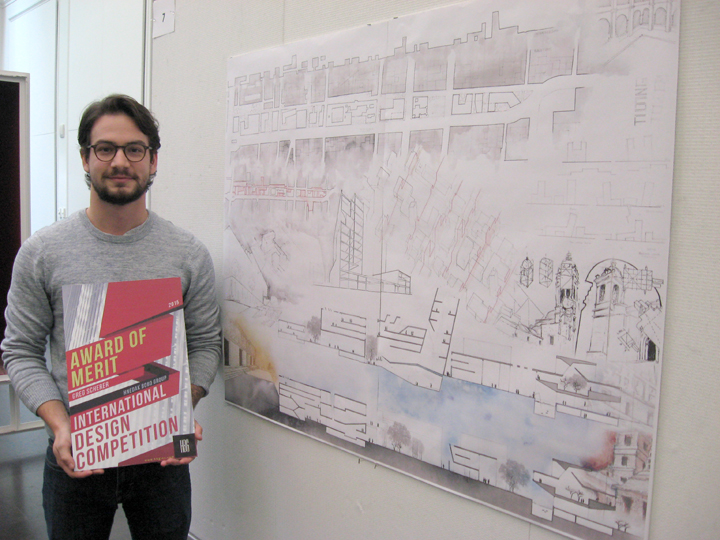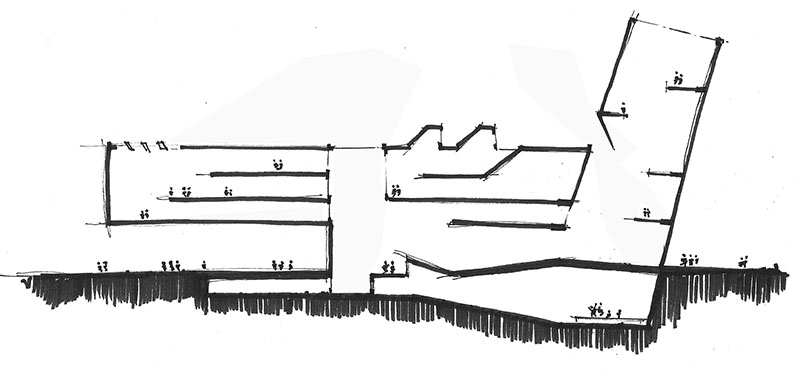
Greg Scherer, shown here, and Edmundo Gonzalez won an Award of Merit for a design they created in the Mexico City studio. (Photo by Mattie Bailey)
By Mattie Bailey
Five University of Arkansas students in the Fay Jones School of Architecture and Design were recognized earlier this semester for their design work through the eighth annual Hnedak Bobo Group International Design Competition. This is the third of three installments that explore their design projects and their study abroad experiences in Rome and Mexico.
Russell Rudzinski, director of the Latin American Urban Studio, said this was the program’s second year of looking at larger scale questions about the historic center of Mexico City. Their studio focused on the University of the Cloister of Sor Juana, which is a private university located in a former convent. The convent was founded in 1585 by joining two private residences, and it has undergone many changes over the years. The university was founded in 1979, and took over the site.
During the 10-week session in summer 2015, instructors asked students to develop a design scenario that assumes a 10-year radical expansion of the University of the Cloister of Sor Juana’s campus making it a truly “urban campus” marking the boundary of the United Nations Educational, Scientific and Cultural Organization site along Jose Maria Izazaga [a six-lane, one-way street] and serving as the new face for visitors to the Centro Historico.
Students worked in a single group on the design proposal for two weeks. The first step was to develop several distinct and different scenario ideas for how the massing, space, organization and movement along the urban edge can be imagined. The students brainstormed multiple options for the development of the whole site. Those options could be a reaction to, or reinforcement of, some of the observations students had made in their study of the Centro Historico. Other options could take ideas or architectural questions that emerged from the travel research as well as students’ own ideas about making space in the city.
Knowing that the use of the space in a project of this scope and magnitude can change radically over time, the students focused on how people move, the integration of new systems into existing systems and the elaboration of a spatial urban network appropriate to the problems of the 21st century city against the immediate context of the 16th century city.
Greg Scherer, a fourth-year architect student from Little Rock, and Edmundo Gonzalez, a fifth-year architecture student from Cuba, shared an Award of Merit for their work. Scherer said his project was a 10-fold expansion of a local university located at the southern perimeter of Mexico City’s Centro Historico that dealt with creating a strong public and private relationship between the university and the surrounding local context. He and Gonzalez tried to make a contemporary take on historic strategies for space making that they discovered throughout their travels and time in Mexico.
Scherer and Gonzalez developed a fascination with the unstable ground of the Mexico valley, Rudzinski said.
“Throughout the Centro Historico there are many colonial buildings that are tilted, warped or bent due to unseen sub-surface conditions,” Rudzinski said. “They seized on the dynamic potential of those forms to generate sectional relationships that organized the campus and enabled playful separations of public and private space.”
Scherer said they spent three weeks traveling throughout Mexico and one week analyzing the Centro Historico and the project site. The remaining six weeks, he and Gonzalez worked on developing their studio project.
“For me, Mexico was the immediate choice right away,” Scherer said, “because I find that, as a culture, it is heavily under appreciated and acknowledged, despite making up about a third of our North American continent. This studio is exclusive in the fact that we get to live with host families during our time in Mexico City. This was crucial in understanding the culture and local neighborhoods in which we would live and work.
“This trip forced me to open my eyes and see the world differently and was absolutely surreal,” Scherer continued. “If I could do this trip again, I would and I strongly suggest it for anyone who is really looking to study abroad, and not just go abroad. This program has made a permanent impact on myself, as a person, and how I see the world and my work. To date, this has been one of the best experiences of my life.”
Gonzalez said the scheme for his and Scherer’s project intended to achieve synchronicity between pre-colonial structures and contemporary architecture.
“Many of the old buildings in Mexico City are sinking or rising, sometimes both, due to those structures being built on top of a lake,” Gonzalez said. “For me, this was a critical aspect to be reflected.”
Read more about the UA Rome Center studio.
